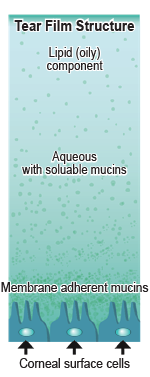
Dry Eye Disease
New Nano-Phased Lipid Technology Represents Advancement in Restoring the Pre-corneal Tear Film (PCTF)
We have tried many treatments for dry eye disease (DED) and, for the most part, found them all lacking. Older, more traditional wetting agents are insufficient when it comes to attacking the root causes of this multifactorial condition, particularly as it affects patient comfort. Some newer, more complex agents have been developed and seem to be a step forward. We recently had the opportunity to try a new formulation containing a proprietary blend of nano-phased lipids and an in-situ gelling agent and were pleasantly rewarded with positive findings, clinically and in patient satisfaction. One key component of DED is a breakdown of the mucin layer that is responsible for converting the hydrophobic corneal surface of the eye to one that is hydrophilic. This allows the pre-corneal tear film (PCTF) to coat the surface of the eye filling in surface irregularities and providing optimal coverage. Patient comfort is often a direct result of the range of sufficient coverage afforded by the PCTF. NanoTears™ contain natural mucomimetic characteristics which help the patient become more comfortable almost immediately upon instilling the drop.

Another, very important component of DED is a deficiency of the lipid component of the PCTF, leading to evaporative dry eye disease (EDED). This evaporation causes the aqueous component of the tears to increase in osmolarity, which ultimately may be the final common pathway in dry eye pathology. The eye abhors the higher osmolarity and seeks natural ways of dilution. This leads to drawing water up through the surface cells of the eye, damaging them and leading to the clinical finding of conjunctival staining, and subsequently, corneal staining.
Sometimes Meibomian Gland Dysfunction (MGD) leads to secretion of what ultimately breaks down into fatty acids, which are toxic and destabilizing to the tear film. Controlling MGD is critical, but beyond that, reconstructing a healthy PCTF is essential to controlling the disease and making the patient comfortable again.
The nano-phased lipid component in NanoTears™ helps lower tear osmolarity by repairing and restoring the surface lipid layer, reducing tear evaporation and allowing for proper aqueous buildup and dilution. Other attempts have been made to develop an ophthalmic solution containing a lipid component to rebuild or restore the lipid layer of the PCTF. Nevertheless, almost by necessity, these preparations consist of a cloudy, somewhat opaque fluid, causing blurring that may last for several minutes after instillation. NanoTears™ have helped to alleviate this problem by using its proprietary NanoPid™ technology, allowing the drop to be clear, permitting immediate relief without causing the blur commonly associated with other products.
I used this product in a preliminary study and was immediately struck with the effectiveness of the product. Among the questions posed to patients in the study was one asking whether they had immediate blurring of vision. This was not a problem, and the vision remained clear even after instillation. Many of the study patients had a long history of dry eye and ocular discomfort, so they were a good test for the response to this drop. I was impressed with the marked improvement in the Ocular Surface Discomfort Score, and with how many patients spontaneously commented that their eye felt more comfortable almost immediately, and that the eye seemed to “cool off” with this drop. In a subsequent study, I followed patients for two months and even in that short time was able to document a substantive increase in Tear Break-Up Time (TBUT) and reduction in corneal staining.
Some of the responses to the product from my patients participating in the study:
“Usually my drops blur my vision for 30 seconds or so. With this drop I could see clearly almost right away.”
“My usual drops make my eye feel wetter, but there’s still an underlying scratchy feeling. These drops were soothing and made my eyes feel better.”

“These drops are very comfortable. I could tell right away they were working.”
All in all I was impressed with this drop, and believe that the proprietary combination of nano-phased lipids, demulcent, and in-situ gelling agent seem to provide long term desiccation protection without the blurring typically found with more traditional ophthalmic gels.

